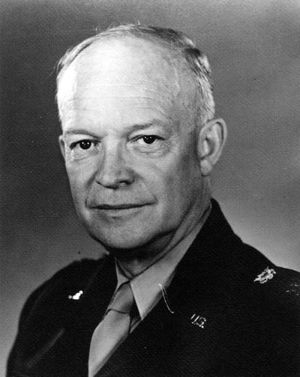Dwight D. Eisenhower: Difference between revisions
imported>Richard Jensen (add bibl) |
imported>Hayford Peirce (added "the passage of the first civil rights bill in 82 years" -- see today's NYT Op-Ed page) |
||
| Line 3: | Line 3: | ||
General of the Army '''Dwight David Eisenhower''' ("Ike") (1890-1969) was an [[United States|American]] soldier who fought in [[World War I]], was a top commander in [[World War II]], and served as the 34th [[U.S. Presidents|president of the United States]] (1953-1961). During the war he first commanded Ally troops in [[North Africa]] in 1942, then became the Supreme Commander of the forces that invaded Normandy on [[D-Day]], June 6, 1944. | General of the Army '''Dwight David Eisenhower''' ("Ike") (1890-1969) was an [[United States|American]] soldier who fought in [[World War I]], was a top commander in [[World War II]], and served as the 34th [[U.S. Presidents|president of the United States]] (1953-1961). During the war he first commanded Ally troops in [[North Africa]] in 1942, then became the Supreme Commander of the forces that invaded Normandy on [[D-Day]], June 6, 1944. | ||
Eisenhower's political affiliations were unknown for many years and he was courted by both the Democratic and Republican parties. Eventually he declared for the Republicans and was elected to the presidency as a moderate Republican. His presidency was marked by the armistice in the [[Korean War]], the construction of [[Interstate Highway System]], the [[Eisenhower Doctrine]] of the [[Cold War]], and moderate domestic policies known as "dynamic [[American conservatism|conservatism]]". Although a renowned military figure, at the end of his presidency, Eisenhower issued a famous warning to the American public about the dangers of the [[military-industrial complex]]. | Eisenhower's political affiliations were unknown for many years and he was courted by both the Democratic and Republican parties. Eventually he declared for the Republicans and was elected to the presidency as a moderate Republican. His presidency was marked by the armistice in the [[Korean War]], the construction of [[Interstate Highway System]], the [[Eisenhower Doctrine]] of the [[Cold War]], the passage of the first civil rights bill in 82 years, and moderate domestic policies known as "dynamic [[American conservatism|conservatism]]". Although a renowned military figure, at the end of his presidency, Eisenhower issued a famous warning to the American public about the dangers of the [[military-industrial complex]]. | ||
==1952 Presidential campaign== | ==1952 Presidential campaign== | ||
Revision as of 11:22, 12 September 2007
General of the Army Dwight David Eisenhower ("Ike") (1890-1969) was an American soldier who fought in World War I, was a top commander in World War II, and served as the 34th president of the United States (1953-1961). During the war he first commanded Ally troops in North Africa in 1942, then became the Supreme Commander of the forces that invaded Normandy on D-Day, June 6, 1944.
Eisenhower's political affiliations were unknown for many years and he was courted by both the Democratic and Republican parties. Eventually he declared for the Republicans and was elected to the presidency as a moderate Republican. His presidency was marked by the armistice in the Korean War, the construction of Interstate Highway System, the Eisenhower Doctrine of the Cold War, the passage of the first civil rights bill in 82 years, and moderate domestic policies known as "dynamic conservatism". Although a renowned military figure, at the end of his presidency, Eisenhower issued a famous warning to the American public about the dangers of the military-industrial complex.
1952 Presidential campaign
Part of Eisenhower's campaign was the employment of a very catchy slogan--"I Like Ike"--that was produced in part by Roy Disney and the Citizens for Eisenhower-Nixon. This slogan was illustrated in a short animation[1], as well as on wearable pin-on buttons.
See also
References
- Albertson, Dean. Eisenhower as President (1963)
- Alexander, Charles C. Holding the Line: The Eisenhower Era, 1952-1961 (1975)
- Ambrose, Stephen E. Eisenhower: Soldier and President (2003)
- Damms, Richard V. The Eisenhower Presidency, 1953-1961 (2002)
- Divine, Robert A. Eisenhower and the Cold War (1981)
- Greenstein, by Fred I. The Hidden-Hand Presidency: Eisenhower as Leader (1991)
- Harris, Seymour E. The Economics of the Political Parties, with Special Attention to Presidents Eisenhower and Kennedy (1962)
- Krieg, Joann P. Dwight D. Eisenhower, Soldier, President, Statesman (1987)
- Olson, James S. Historical Dictionary of the 1950s (2000)
- Pach, Chester J. And Elmo Richardson. Presidency of Dwight D. Eisenhower (1991)
- Parmet, Herbert S. Eisenhower and the American Crusades (1972)
- [http://www.questia.com/PM.qst?a=o&d=91954887 Pogue; Forrest C. The Supreme Command (1996)}
- Sixsmith, E. K.G. Eisenhower, His Life and Campaigns (1973)
Primary Sources
- Eisenhower, Dwight D. Mandate for Change, 1953-1956 (1963) important memoir
- Eisenhower Papers 21 volume scholarly edition; complete for 1940-61.
References
- ↑ Internet archive, Eisenhower Campaign Spots (1952). Retrieved on 2007-09-11.
